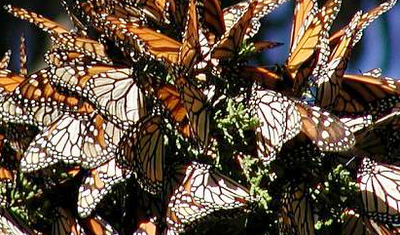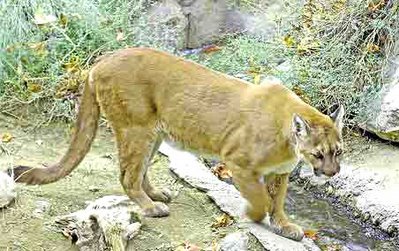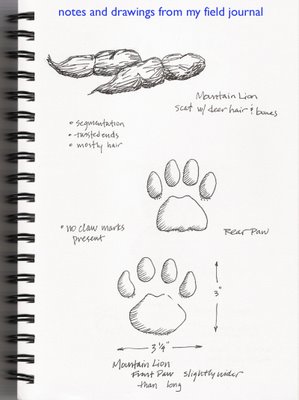Magical Monarchs

by Steven Harper
With a big grin and quiet laughter I stepped cautiously along the garden path as literally hundreds of butterflies swarmed around me in all directions. Many ran into or landed directly on me as I went about my work. It was a sunny January day some thirty years ago. I was working in one of the most beautiful coastal gardens and this was my first encounter with masses of the orange and black Monarch butterfly. I was filled with a lightness of being, wonder, and many questions. Most of my questions went unanswered, but the wonder never left.
Who among us can think of butterflies without the corners of our mouths turning upward? What better butterfly to bring a smile to our face than the magnificent Monarch butterfly? While many butterflies can only be identified by an entomologist, even the insect-illiterate can identify a Monarch butterfly. It is probably the most commonly recognized butterfly in North America. While watching one dart from plant to plant is plenty enough to inspire a lightness of heart, knowing more about these beautiful insects can deepen our appreciation for these miraculous creatures.
Background
Butterflies along with moths belong to the insect group Lepidoptera. Monarch butterlies (Danaus Plexippus) belong to the family of milkweed butterflies that feed only on milkweed (Asclepias). All butterflies go through four distinct developmental stages of egg, larva, pupa, and adult in a process called metamorphosis. Butterflies need mild temperatures for their active life and either hibernate or migrate to escape the cold. Monarchs migrate and in North America there are basically two populations of Monarchs. This article deals primarily with the western Monarch (those that live west of the Rocky Mountains). We will follow the Monarch through its life cycle on the central coast, to its multi-generation movement north and inland, and finally, to its long migration as it returns.
Arrival
Starting in October we begin to see the arrival of Monarchs to the central coast. Their arrival is the culmination for some individuals of a 2000-mile journey. They are the flight distance champions of the butterfly world. Their arrival is seemingly miraculous as the arriving butterflies have never before been here and are in fact many generations removed from the butterflies that left the year before. They choose protected openings in forested areas near the coast from north of the San Francisco Bay area south to northern Baja California in Mexico. Most often they choose Eucalyptus trees, but they also choose forests of Monterey Pine and Cypress.
Winter Habitat and Behavior
Monarchs need water, food (nectar), mild temperatures, and protection from the elements to endure the winter. Monarchs must drink water each day and between the morning dew, fog, and winter storms there is usually plenty of available water on the trees the butterflies choose. The non-native eucalyptus tree is in bloom and provides nectar in the winter months so it is often favored over the native trees as overwinter habitat. Additionally, they need just the right temperature. If it is too cold or too warm they use up precious energy reserves trying to moderate their temperature and will die. Coastal California offers just about the right conditions most years. During the winter months the butterflies must conserve their energy. You can see large football size clumps of butterflies holding on the same branch. A careful observer can watch the butterflies move to the sunny spots of a tree to warm themselves and then seek shady spots as the day heats up. From a distance I have witnessed entire Monterey Pines with an orange brown cast to them that looked like they were dying. Only to discover up close that they were covered, yes I mean covered, with Monarchs on every branch.
Mating
Although it varies from year to year, some time around February when the first milkweed begins to show itself some many miles away, the butterflies decide it is time to mate. In the latter part of winter we often get a break in the storms and the coast of California puts on a clear blue-sky day that feels like summer. This is the perfect day for Monarch watching. Males take to the sky with pheromone scent pouches full in search and pursuit of females. After an aerobatic chase the male “dusts” the female with pheromones at which time the female will often loose her ability to fly and fall to the ground in the grasp of the male. On the ground the two will flail around in what appears to be a struggle until the male is able to successfully hook up. At this point the female closes her wings and becomes completely passive. After a moment the male will take off up into the trees with the female hanging beneath him like the keel of a ship. Males can only mate a few times before they die where as the female will soon begin her journey.
The Journey
The fertilized females journey northward and inland in search of the first available milkweed growth. Once milkweed is found a female will go about testing the milkweed for a compound that is toxic. Butterflies have taste organs in the hairy bristles of their front feet. The more toxic the leaf the better, as this toxicity is a key to the Monarch’s ability to survive at all stages of its life (more on this later in the article). Each time a female finds a leaf that meets her approval she will lay a single egg out of a few hundred or so she might carry. Soon after the overwintering female lays her last egg she dies. It is up to the next generations to continue the migration.
The egg hatches and out crawls a small hungry caterpillar. During this larva period the caterpillar will eat milkweed ravenously and will expand its size by well over 2000 times in an average of 15 days. The caterpillar will enter a pupation period in a chrysalis for 10 to 15 days. During this time an incredible transformation occurs. Caterpillar body parts disappear, or change while butterfly parts appear and grow. Adults emerge from their chrysalis soft and damp. They must pump blood and air through their body and wings while waiting for their exoskeleton and wings to dry and harden. In a few hours they are ready to take to the air in their first flight.
The second generation since leaving the coast will live only 4 to 8 weeks, enough time to make their way further north and inland. The cycle continues for a third and even fourth generation until they make their way as far as Canada and the western parts of Rocky Mountains states with some remaining in California. It is the third and fourth generations that make the long return flight to the California coast. These returning Monarchs, the ones we see along the coast, will live about 7 to 8 months.
The Milkweed Connection
By feeding on the toxic milkweed plant the caterpillar is not only growing itself at an amazing pace it is also protecting itself for the rest of its life. The chemicals (cardenolides) stored in the Monarch body taste terrible and are poisonous to insects, birds, and other predators that may try to feed on them. As common with many animals in nature, if they are poisonous, they advertise this with bright colors, high contrast, and distinguishing marks just as the Monarch does. This strategy also benefits them as they overwinter in mass along the coast. It doesn’t take long for the potential predators to figure out that while the Monarch’s might be easy pickings they are not very tasty.
The Mystery of Monarch Migration
It is still not understood or agreed upon how Monarchs that have never been to their over-winter locations make the up to 2000-mile journey. It is probably a constellation of factors including the magnetic field of the earth, the position of the sun, use of ultraviolet light receptors, chemical smells, and other factors not yet recognized by scientists that guide the way.
Imagine your species survival is at stake. Imagine never having been shown the location or the way to the critical habitat for your species. Imagine navigating from 2000 miles to only a relatively few locations that will allow you to survive the winter. Imagine negotiating the challenges of winter storms, extreme temperatures, drought, habitat loss, pesticides, and the windshields of speeding cars. Imagine you must go. Now—wonder—the miracle of the Monarch.
Labels: Big Sur, monarch butterflies, monarchs, Monterey



